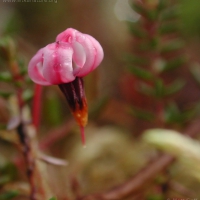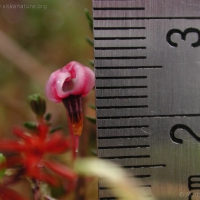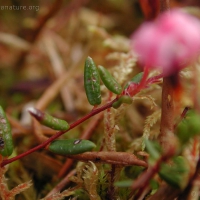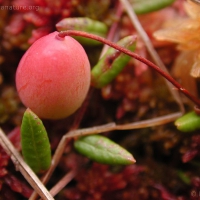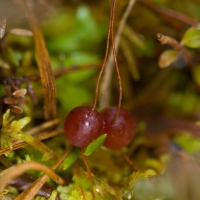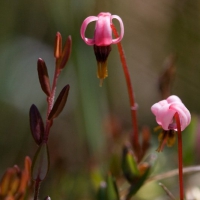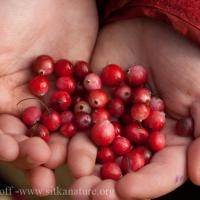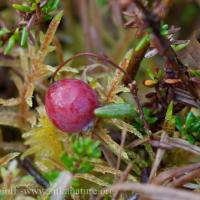Bog Cranberry – k̲’eishkaháagu
Disclaimer: While I have a reasonably broad knowledge of the natural history of Southeast Alaska (especially birds and plants), I am only an intermediate Tlingit language learner. This page has been created as part of my learning process; I welcome comments and corrections, and in posting this publicly I hope that it can also be of some help to other learners. For additional resources, see tlingitlanguage.com
Dictionary of Tlingit: k̲’eishkaháagu – bog cranberry; low bush cranberry
Tlingit Noun Dictionary: k̲’eishkaháagu – cranberry: very small
Interior Tlingit Noun Dictionary: k̲’eishkaháagu – bog cranberry; (C also) low bush cranberry (Oxycoccus microcarpus)
R. Littlefield Document: k̲’eishkaháagu – Cranberry, bog (oval, thin stalk, few leaves)
Bog cranberries (Vaccinium oxycoccus; O. microcarpus is a synonym of the cranberry species common in eastern North America, but not the west) are very low growing plants common in muskegs. They grow as a small thin woody stem with small leathery evergreen leaves right along the surface of the bog. The flowers are small pink crane’s-bill type flowers. Considering the small size of the plant, the berries end up seeming quite large, relatively speaking. Abundance varies from year to year, but around Sitka at least, with some effort at searching and a little patience, it’s not usually too hard to find a quart or more (and ambitious people in a good year have been known to pick well over a gallon).
It appears that at least in some places, k̲’eishkaháagu may also refer to low bush cranberry (Vaccinium vitis-idaea) which I discuss under dáxw.
I’m not sure if this name can be sensibly broken down, but it does appear that the last part might come from kaháakw which is fish eggs/roe. I do not know what k̲’eish might mean, though.
Additional photos of Bog Cranberry (Vaccinium oxycoccus):

